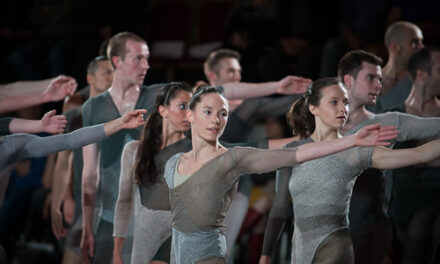The Eastern Music Festival fields two full-sized student orchestras which are pretty evenly matched in talent. Each works regularly with its own conductor or a guest and plays an entire concert on Thursday or Friday night, except for the final week of the festival when both orchestras split the duties, one accompanying student concerto winners one night while the other does so the second night. Concerto winners, playing excerpt movements from concertos, are featured before intermission and largely orchestral works afterward. This year’s soloists have already built up impressive biographies filled with accounts of the conservatories, the festivals, or well-known youth orchestras in which they have played. Dana Auditorium was well-filled with students’ relatives and expectant music lovers.
The Concerto in A, K. 622 is one of Mozart’s most beloved works for solo wind instrument and orchestra. He composed it for the basset horn, which was invented by a German instrument maker. “Basset” in the musical sense is merely the diminutive of “bass.” The instrument has an extended lower range. The concerto is almost always heard played on a clarinet, as it was on this occasion. The first movement “Allegro” was played with fine style and great skill by Lara Mitofsky Neuss, a native of New Jersey who is currently entering her sophomore year at the San Francisco Conservatory of Music. Her breath control was excellent as was her intonation, and her phrasing was apt. Eric Garcia conducted the Guilford Young Artists Orchestra in a mostly elegant performance while providing his soloist with carefully balanced accompaniment. All the string sections played with a closely matched ensemble. Mozart’s scoring is very unforgiving of any error. No doubt the short-notice for rehearsal involved with these concerto excerpts played a role in more clunkers than usual in the horns.
The Second Piano Concerto in G minor, Op. 16 of Prokofiev is seldom programmed and has had a checkered reputation since its debut in 1913. This version was lost in a fire in 1917 during the Russian Revolution and the composer reconstructed it from his sketches, perhaps taking advantage of his artistic growth, and reintroduced it in Paris in 1924. The discursive opening features expansive melancholy themes. Prokofiev scores for the flute and oboe in their highest registers and the “Andantino” first movement is in the middle of a huge cadenza for the piano. Wisconsin native Kyle Coolidge was the assured, cool soloist who had fine control of long phrases and a wide dynamic range which was shown to great effect over the course of the famous cadenza. Garcia led a solid, well-balanced and stylish accompaniment. He brought out the broad range of Prokofiev’s score, one moment ethereal, warm string, the next tart, with edgy, wiry strings. Coolidge is currently studying with Yoshikazu Nagai at the San Francisco Conservatory of Music. Nagai was a member of the EMF piano faculty for several seasons ending in 2010.
Liszt drafted his Second Piano Concerto in A in 1839 and put it aside for ten years before revising it repeatedly before its premiere in 1857, two years after the First Piano Concerto’s debut. It consists of six sections intended to be played as one continuous movement. Unlike the thundering octaves and glitter of the First, the Second Concerto puts a premium on poetry.
Michael Delfin is a native of California and a student at The Johns Hopkins University. He recently completed his second year of the Bachelor of Music at the university’s Peabody Conservatory and is also pursuing a Bachelor of Arts in mathematics at the university. Delfin gave a beautiful performance of great warmth, and the performance was remarkable for the chamber music-like interplay between his keyboard and orchestra principals. The orchestra’s accompaniment, led by Garcia, was excellent across the sections with fine turn from the woodwinds and brass. The trills of the clarinet were given by Patrick Englert, the fine toned principal oboist was Michael Johnson, and the delightful horn solo before the concluding, almost Mendelssohnian quicksilver dash, was provided by Kayln Jang. The highlight of the performance was Delfin’s duet with mellow toned cellist Natalie Parker.
Berlioz’s Harold in Italy, Op. 16 is really a symphony rather than a concerto although it does feature a reflective solo for the viola. Violin superstar Paganini asked Berlioz for a work in which he could show off his virtuosity on a fine Stradivarius viola. Having wanted a flashy showpiece, he never played Harold in Italy because he said it was too full of rests. After later hearing the work, he gave Berlioz a gift of 20,000 francs. Lord Byron’s narrative poem Childe Harold Pilgrimage was hot stuff at the time and episodes provided titles for the symphony’s four movements: “Harold in the Mountains,” “March of the Pilgrims,” “Serenade of an Abruzzi Mountaineer,” and “Orgy of the Brigands.” Paganini had wanted an “action-hero,” in the midst of everything, not Berlioz’s Harold, an “observer and commentator” on the action.
Conductor José-Luis Novo led the second EMF Young Artists Orchestra in dynamic and vital performance of Berlioz’s Romantic work. His guest soloist was Robert Vernon, who has recorded the work, is now in his 31st year as principal viola of The Cleveland Orchestra. Vernon used a score but was never lost in it. He produced a gorgeous, warm viola tone which projected well into the hall. All sections of the orchestra played well and there were only occasional ensemble lapses. Among the many fine student solos were those of the clarinetist Adam Trinkoff, Hirofumi Tanaka on horn, and the third movement’s English horn player Rachel Schlesinger.




![[dnme] Duke New Music Ensemble with Rela Percussion on December 4](https://cvnc.org/wp-content/uploads/2023/08/Duke_2016-1204_Eren-220x264.jpg)







